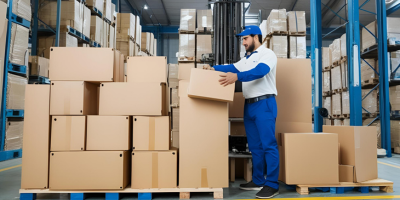A R T I C L E
Export Packing Best Practices: A Complete Guide for Safe & Efficient Shipping

Published on May 9, 2025 | 8 mins read
In today’s global marketplace, the journey your product takes from warehouse to end user is as crucial as the product itself. Export packing is the frontline defense that protects goods from damage during international shipping. This guide walks you through best practices for export packing that ensure your shipments arrive intact, compliant, and cost-effective.
Why Export Packing Matters
Export packing is more than just putting products into boxes. It safeguards against physical damage, moisture, vibration, compression, and even theft. Proper packing also ensures customs compliance, optimizes container space, and minimizes costly returns or disputes. Ultimately, it builds trust with clients and boosts your brand's credibility globally.
1. Understand the Nature of Your Cargo
Different types of cargo require different handling and packing strategies. Start by classifying your goods:
Knowing your cargo helps determine the level of protection required and the appropriate materials to use.
2. Choose the Right Packing Materials
Select packing materials based on durability, load-bearing capacity, and environmental conditions. Some essentials include:
Always ensure materials are export-grade and comply with destination country regulations.
3. Optimize for Container Efficiency
Space is money in logistics. Efficient packing reduces freight costs and lowers the risk of damage:
- Stack Smart: Place heavier items at the bottom and lighter ones on top.
- Use Void Fillers: Prevent items from shifting inside boxes or crates.
- Standardize Box Sizes: Improves palletization and container loading.
- Align with Container Dimensions: Avoid odd shapes or sizes that waste space or need custom handling.
4. Weatherproof & Moisture-Proof Your Packaging
International shipments often face exposure to moisture, salt air, and temperature fluctuations. Protect your cargo with:
- Plastic Wrap & Liners: Create barriers against water and humidity.
- Desiccant Packs: Absorb moisture within sealed packaging.
- Vapor Barrier Foils: Prevent condensation in metal equipment or electronics.
- Sealed Crating: Especially important for sea freight.
Such steps are critical for long-distance and cross-ocean transport.
5. Labeling & Documentation: Accuracy Is Key
Proper labeling ensures smooth customs clearance and reduces handling mistakes:
- Shipping Labels: Must be legible, waterproof, and placed on multiple sides.
- Handling Labels: Indicate if goods are fragile, flammable, or heavy.
- Export Documents: Include packing lists, commercial invoices, certificates of origin, and MSDS (for chemicals).
Use barcoding or QR codes where possible for easy tracking and automation.
6. Use Custom Crating for Odd-Shaped or Heavy Machinery
Standard packaging doesn’t always fit the bill. For oversized, odd-shaped, or fragile industrial machinery, custom wooden crates with internal supports or foam molds offer the best protection.
- Tailored to the product's dimensions
- Shock-absorbing mounts for vibration-sensitive items
- Reinforced for load-bearing and lifting safety
Custom crating is also essential for artworks, instruments, and delicate equipment.
7. Conduct Drop & Vibration Testing (When Applicable)
Before full-scale shipment, test your packaging design using industry standards like:
- ISTA (International Safe Transit Association) protocols
- Drop tests from 30–100 cm heights
- Vibration simulations mimicking road or sea freight
This ensures your packing can withstand real-world transit conditions.
8. Partner with Professional Export Packers
In complex or high-volume shipments, working with an expert export packing service brings:
- Compliance with international standards (e.g., ISPM 15, HAZMAT)
- Access to industrial-grade materials
- Custom-engineered packaging solutions
- Efficient warehouse lashing and container stuffing
Professionals reduce the risk of costly errors and ensure faster turnaround.
9. Consider the Mode of Transport
Your export packing should adapt to your mode of shipment:
Sea Freight:- Requires water-resistant and corrosion-proof packaging
- Extra strapping or lashing to prevent shifting
- Weight is critical—use lightweight but sturdy materials
- Compact, space-saving packaging is preferred
10. Sustainability in Export Packing
Eco-friendly packaging is gaining importance. Use:
- Recyclable or biodegradable materials
- Reusable crates or pallets
- Minimalist packaging without compromising safety
Sustainable practices can reduce costs in the long term and enhance your corporate image.
The Benefits of Getting It Right:
Mastering export packing leads to several key benefits:
- Reduced damage and loss
- Lower freight and insurance costs
- Faster customs clearance
- Improved customer satisfaction
- Enhanced operational efficiency
Whether you're shipping electronics, heavy equipment, or fragile goods, investing in proper export packing is a smart and essential strategy.
Related Articles:
Tags:
Subscribe to Sealine Journal
Stay updated with the latest logistics and supplychain insights.
Subscribe Now!